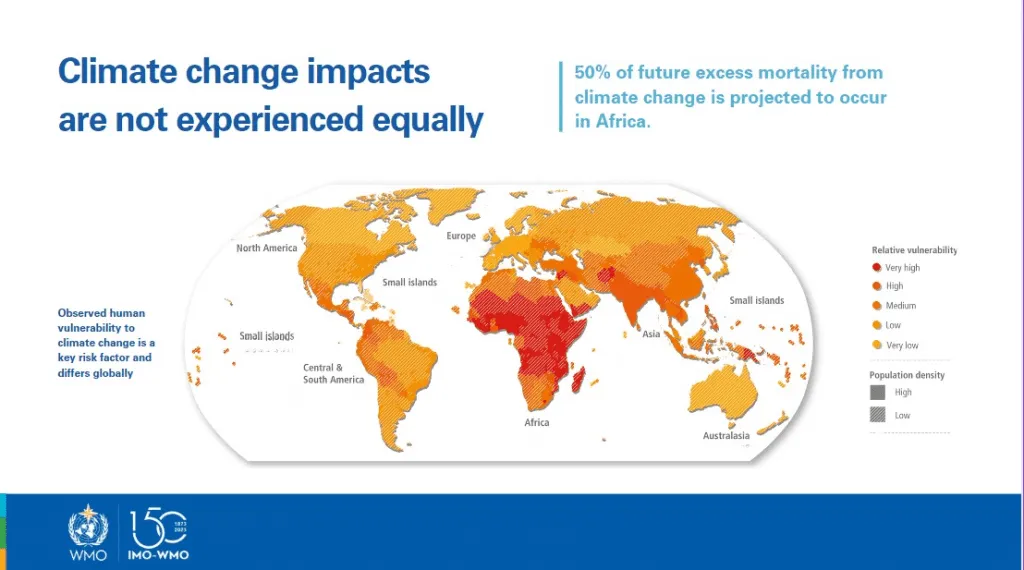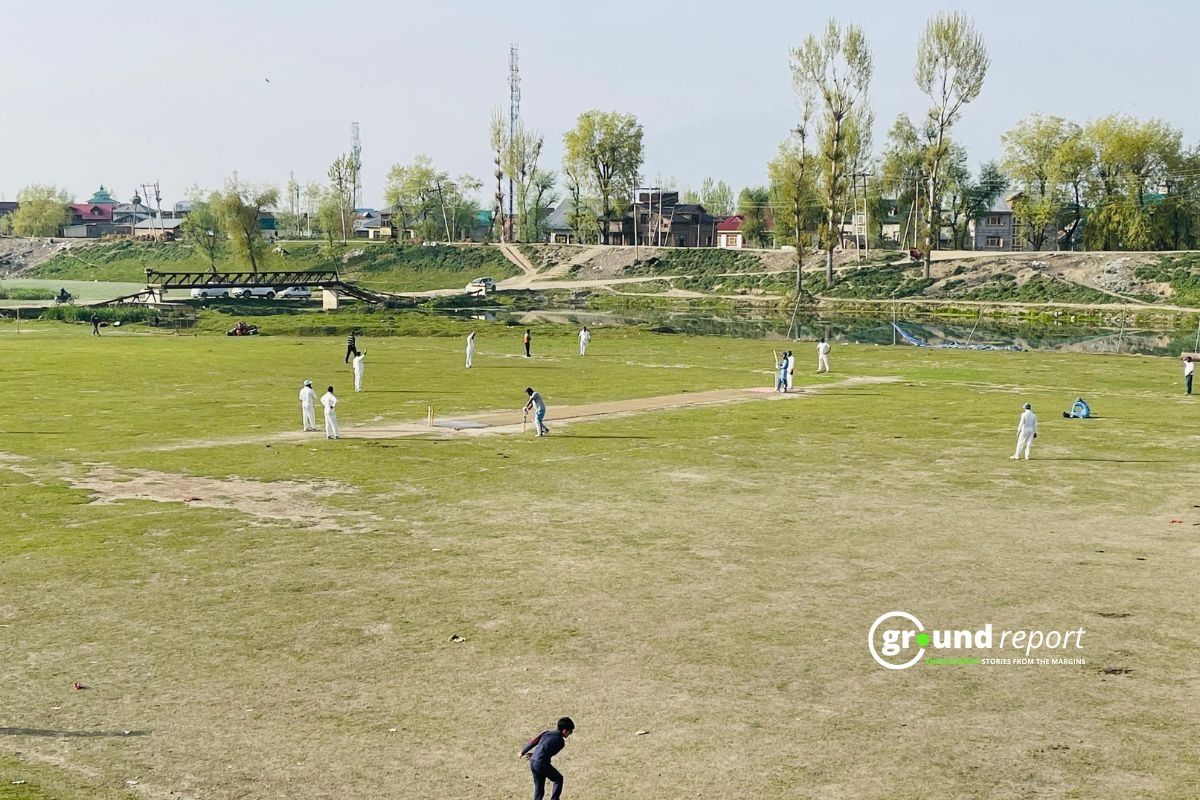- Climate change threatens global health, particularly in vulnerable communities, and could undo decades of progress.
- Tailored climate information is crucial to address health impacts from extreme weather, air quality issues, and changing disease patterns.
- Investment and collaboration are needed to enhance climate science and services for the health sector to mitigate the health risks of climate change.
The world is warming at a faster rate than at any point in recorded history, putting human health on the frontline. Climate change could reverse decades of progress towards better health and well-being, especially in the most vulnerable communities. Scientific know-how and resources have the potential to redress the balance, but a new multi-agency report coordinated by the World Meteorological Organization (WMO) indicates they are not sufficiently accessible or utilized.
Climate impact on health underreported
The report highlights the need for tailored climate information and services to support the health sector as it grapples with the impacts of more extreme weather, poor air quality, shifting infectious disease patterns, and food and water insecurity.
“Practically the whole planet has experienced heatwaves this year. The onset of El Niño in 2023 will greatly increase the likelihood of breaking temperature records further, triggering more extreme heat in many parts of the world and in the ocean – and making the challenge even greater,” says WMO Secretary-General, Prof. Petteri Taalas.
“It is clear that by channelling investment and boosting collaboration, there is huge potential to go further and faster by enhancing the impact of climate science and services so that health partners get the support they need at a time when unprecedented changes to our climate are having an increasing impact,” says Prof. Taalas.
Dr Tedros Adhanom Ghebreyesus, WHO Director-General, described the climate crisis as a health crisis, driving more severe and unpredictable weather events, fuelling disease outbreaks, and contributing to higher rates of noncommunicable diseases.
Despite nearly three quarters of National Meteorological and Hydrological Services (NMHS) providing climate data to the health sector, uptake remains limited. Less than a quarter of Ministries of Health have a health surveillance system that utilizes meteorological information to monitor climate-sensitive health risks.
Early Warnings for All
The report projects that the number of medium- or large-scale disaster events will reach 560 a year – or 1.5 each day – by 2030. The report cites figures showing that countries with limited early warning coverage suffer a disaster mortality rate eight times higher than countries with substantial to comprehensive coverage.
They devote a special section to extreme heat, which causes the greatest mortality of all extreme weather. However, they underestimate the impacts as heat-related mortality could be 30 times higher than what they currently record. Only half of the affected countries receive heat warning services for health decision makers, but they expect these services will rapidly increase by 2027 under the international Early Warnings for All initiative.

Estimates from between 2000 and 2019 indicated that heat accounted for approximately 489,000 deaths per year, and Asia (45%) and Europe (36%) bore a particularly high burden. Authorities estimated that extreme heat conditions claimed over 60,000 excess deaths in 35 European countries during the summer of 2022.
Heatwaves intensify air pollution, increasing deaths
Heatwaves also exacerbate air pollution, already causing an estimated 7 million premature deaths every year and standing as the fourth biggest killer by health risk factor.
Climate change exacerbates the risks of food insecurity. From 2012-2021, extreme drought affected 29% more global land area for at least one month per year than it did from 1951–1960. The compounding impacts of droughts and heatwave days associated with 98 million more people reporting moderate to severe food insecurity in 2020 than annually in 1981–2010, in 103 countries analysed, according to figures the report cited.
The changing climatic conditions also enhance the transmission of many infectious vector-, food-, and water-borne diseases that are climatically sensitive. For instance, dengue has become the world’s fastest-spreading vector-borne disease, and the malaria transmission season has lengthened in some parts of the world.
The report says that some of the most significant health challenges are in the nexus of water, food security and nutrition, the nexus of infectious diseases (food-, water-, airborne and vector-borne diseases), and the nexus of extreme weather and air quality, particularly in urban areas.
Climate change impacts health and requires action
Climate change poses a significant threat to human health, particularly in vulnerable communities, and could potentially reverse decades of progress in health and well-being.
The Intergovernmental Panel on Climate Change (IPCC) has concluded with very high confidence that future health risks from injury, disease, and death will increase due to more intense and frequent temperature extremes, cyclones, storms, floods, droughts, and wildfires. By 2050, it is anticipated that over 50% of the excess mortality resulting from climate change will occur in Africa.
Protecting health is a priority in almost all countries and requires high-quality information for informed decision-making. Climate information and services are crucial for understanding how and when health systems and population health can be impacted by climate extremes and a changing climate, and for managing these risks. Tailored climate products and services can enhance the evidence and information available to health partners to detect, monitor, predict, and manage climate-related health risks.
However, there is a significant potential for enhancing the benefits of climate science and climate services for the health sector and for increasing accessibility, relevance, and uptake. Currently, only 31% of National Meteorological and Hydrological Services (NMHSs) provide climate services at a ‘full’ or ‘advanced’ level of capacity. A wide range of academic, private sector, and government partners are working to fill this gap, and this needs to be put on a sustainable and coordinated footing.
Extreme heat, which causes the greatest mortality of all extreme weather, is a particular concern. Heat warning services are provided to health decision-makers in only half of the affected countries. According to the Lancet Countdown on Health and Climate Change, rising temperatures and the growing over-65 population have triggered an increase in heat-related mortality in this age group of approximately 68% between 2017-2021, compared to 2000-2004.
Climate change threatens heat-related mortality
The Intergovernmental Panel on Climate Change (IPCC) has expressed “high confidence” that Central and South America, southern Europe, southern and Southeast Asia, and Africa will be the regions most affected by heat-related mortality due to climate change by 2100. This is based on projected increases in global temperature of 1.5°C, 2°C, and 3°C.
The IPCC notes with “very high confidence” that the combination of future urban development and the more frequent occurrence of heatwaves expect to cause significant impacts of heat. More hot days and warm nights will increase heat stress in cities.

Air quality, climate change, and health are interconnected issues. Actions to mitigate climate change that lead to reduced air pollution can save lives. However, only 2% of climate finance commitments made by international development funders in developing and emerging countries between 2015 and 2021 explicitly aimed at tackling air pollution, despite it being the most dangerous environmental threat to health.
Air pollution a major global threat
In 2019, air pollution moved up from the fifth to the fourth leading risk factor for death globally, surpassing other widely recognized risk factors for chronic disease like obesity, cardiovascular disease, and malnutrition.
Investment in the health sector is currently insufficient, leaving it ill-prepared to safeguard the most vulnerable. Just 0.2% of total bilateral and multilateral adaptation finance supports projects that identify health as the primary focus, and investment in the capacity for multisectoral and effective climate science and services is minimal.
Stakeholders have not clearly designed most hydrometeorological investments to support health outcomes, a situation that needs change. To fully exploit the potential of climate services for health, stakeholders across the health and climate sectors need to undertake transformational change in institutional development and integration.
The global COVID-19 pandemic has emphasized the social and economic losses that society can suffer when health is compromised. The health community must do more to prepare for potential future shocks and pressures from climate variability and the damaging effects of climate change.
In response to these challenges, the World Meteorological Congress in 2023 approved a 10-year strategy on Advancing Integrated Climate, Environment, and Health Science and Services (2023–2033) in collaboration with WHO and other health partners.
Keep Reading
Part 1: Cloudburst in Ganderbal’s Padabal village & unfulfilled promises
India braces for intense 2024 monsoon amid recent deadly weather trends
Support us to keep independent environmental journalism alive in India.
Follow Ground Report on X, Instagram and Facebook for environmental and underreported stories from the margins. Give us feedback on our email id greport2018@gmail.com.
Don’t forget to Subscribe to our weekly newsletter, Join our community on WhatsApp, and Follow our YouTube Channel for video stories.










